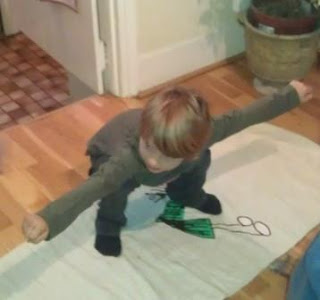By Sue Heron – Training Co-ordinator Tatty Bumpkin and Paediatric Physiotherapist
This week Tatty Bumpkin sets off to visit her friend the giant. He lives in a huge house on the other side of the Giggle Tree, but this house is maybe a little too big for mouse..
Tatty Bumpkin's Mouse Pose
 |
| Can you be a really tiny mouse? |
Note to parents – It a good idea to do mouse pose with your child so they can copy you, this is especially true if your child is younger. Recent research demonstrates that doing activities and movements together helps the bonding process between parents/carers and their child.
- Find a comfortable space on the floor and take off socks and shoes.
- Guide your child to sit back on their heels opposite or alongside you - make sure you have enough space.
- Keeping your arms by your sides, curl forward and pretend to ‘kiss your knees’. It's a good idea to say this to your child so they get the idea of curling forwards into a 'ball' rather than lying on their tummy.
- Once you are curled up in mouse pose - encourage your child to squeeze their muscles - to be a tiny mouse! As your child actively squeezes their muscles and joints they will be activating their proprioceptive sense - see below.
- Be sleeping mice in your little houses - shut your eyes, take deep breaths and lie very still for 15-20 seconds, if you can!
Want to Make it Harder?
- Lift up your head, make squeaking sounds, then wriggle you fingers on either side of your mouth as mousy whiskers.
- Stretch out one leg, then the other, and wave them from side to side. You’re a magic mouse with TWO tails.
- Finally come up onto all fours and scamper round the room to run away from the pesky cat. Can you go under a table or even a chair? Be careful not to bump your heads.
Mouse pose to Tatty Bumpkin's Mouse Song
You can download Tatty Bumpkin Mouse song from iTunes or ask your Tatty Bumpkin teacher about the Tatty Bumpkin CD. Mouse song encourages your child to relax and be still in mouse pose and then to ‘let off steam’ as a mouse scampering away from the cat! https://itunes.apple.com/gb/artist/tatty-bumpkin/id376347825
 |
| Tatty Bumpkin's This is the Life! |
Why Mouse Pose is ‘Good For Me’
Mouse Pose can calm and organise the young nervous system. As your child curls up and squeezes their body in mouse pose they will stimulate their deep touch and proprioceptive senses.
- Deep pressure touch is the most tolerated form of tactile input and tends to be calming and soothing for the nervous system.
- Any push, pull, stretch or ...squeeze on a muscle or joint will stimulate the proprioceptive sense. Therapists love the proprioceptive sense, often calling it the 'safe sense', as its activation can help to organise the nervous system helping a child feel more grounded.
So, when Christmas preparations become just a little too exiting - remember Clement Clarke's Moore's poem 'Twas the Night Before Christmas' and be a christmas mouse! http://blackdog.net/holiday/christmas/twas.html
 |
| 'Twas the night before Christmas..' |
The Tatty Bumpkin Adventure This Week
In this session your child will have a rainbow of opportunities. They will be:
1. Developing their body awareness as they stretch out wide to be giants and curl up small to be mice.
2. Coming up with their own ideas to suggest places for a mouse house!
3. Using gestures or words to express their thoughts i.e. Feeling
- ‘A bit worried’ as they creep into the giant’s house
- ‘Sad’ as a 'mouse without a house'
- ‘Confident’ to go exploring round the giant’s house
- ‘Excited’ at finding the perfect home for mouse
4. Refining their sense of rhythm as they curl up, then scamper to Tatty Bumpkin Mouse song.
5. Calming themselves, and becoming aware of their breath in mouse pose.
6. Developing fine motor skills as they twitch their mouse whiskers and help mouse build his own little house.
7. Having fun with their friends as they:
- Curl up and scamper round the room as little mice.
- Stomp as huge giants.
- Work together to make the perfect little house for mouse.
Find your local Tatty Bumpkin class at http://www.tattybumpkin.com/classes/find-class.html
Love Tatty Bumpkin xx
Tatty Bumpkin Makes Movement Fun, Creative and Educational
- We use unique storylines and music to make our classes meaningful and fun for young children.
- Sessions are multi-sensory to promote regulation skills and spark imaginations. They involve:
- Adapted yoga poses and activities which stimulate and calm the body senses.
- Dedicated songs and rhythms, relevant to the stories.
- Fun, often natural textured props.
- We have carefully linked Tatty Bumpkin to the English Early Years Foundation Stage (EYFS) and the Scottish Curriculum for Excellence frameworks.
A Thought for 2017 - A New Start with Tatty Bumpkin?
Maybe, you are thinking of a new career which gives you:
- The opportunity to work with kids
- A great sense of job satisfaction and
- Flexible working to fit around your own family
Find out how you could be trained to deliver Baby and Tatty Bumpkin classes in your area at: http://www.tattybumpkin.com/business/index.html.






























